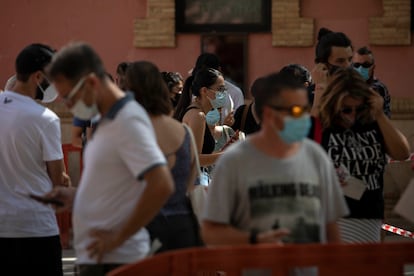More cases among young people and a lower death rate: How the coronavirus epidemic has changed in Spain
Aragón is the only region in the country so far that has seen its infection rate rise since the lockdown deescalation phases came to an end on June 21

If an expert was presented with data from the coronavirus epidemic in Spain in two blocks – from the start until June 21, when the lockdown ended, and from that date up until now – they would struggle to determine that they represented the same pathogen. The age of those being infected, the areas worst affected and the death rates are completely different between the two data sets. The change in behavior of Covid-19 has been achieved thanks to isolating those infected, and monitoring suspected cases – although the recent rise in new cases could reverse this trend. Here is an analysis of the radical changes in the most frequently used indicators.
Death rate. The arrival of the so-called “new normality” after Spain’s strict coronavirus lockdown has been accompanied by a change in the lethality of the virus. When measured by victims per 100 infections confirmed via a PCR test, on June 21 this figure was at 9.07. Nearly two months later, the percentage has fallen to 0.31, which is a drop of 96%. Taking into account that no mutations of the virus have been detected that would justify such a fall, other factors explain this decrease. The first is that more cases are being diagnosed, something that increases the denominator in the deaths-to-cases relationship. The second is that the positive cases being detected now are less serious, most likely because the average age has fallen. And there is a third factor that groups such as Nomorepandemics, an analysis collective from the party Por Un Mundo Más Justo (For a Fairer World) attribute a huge amount of relevance: now that the health system is not overloaded, the best care possible has been available to all of those with Covid-19, avoiding deaths due to the inability to treat everyone in the best conditions possible. This is what is suspected to have happened with residents of senior homes in regions such as Madrid, who were not sent to hospitals for treatment due to their being overwhelmed. This fall in victims caused by the coronavirus is well reflected in the Momo excess deaths study from the Carlos III health institute, which shows that there has been no excess deaths registered compared to previous years from practically the second week of May, when Spain was still in its deescalation phases.
Also of note is the fact that the death rate varies greatly between regions given the combination of aforementioned factors. During the pandemic, and up until June 21, the rate ranged from 6.71% in the Canary Islands to 17.27% in Extremadura, a factor of practically one to three. Meanwhile, in the new normality the proportion runs from 0.12% in Navarre to 0.93% in Castilla y León, a factor of one to nine, although in this case the numbers are very small and an outbreak in a healthcare center or a senior residence can mean a large difference, given that the citizens involved are in a more vulnerable situation than, for example, agricultural workers or young people who become infected at a party or nightclub.
Regions. Aragón is the only one of Spain’s 19 territories monitored (the country’s 17 regions plus the North African exclave cities of Ceuta and Melilla) whose case rate per 100,000 inhabitants has grown since June 21, when Spain’s deescalation phases ended. Taking this date as a starting point, the coronavirus has created two very different maps across Spain, with varied effects between regions, according to the data provided by the Health Ministry and based on reports supplied by the regional governments. On June 21, the average across Spain was 524 cases per 100,000 inhabitants. At the top of the list was La Rioja, a small region that saw a major outbreak at the start of the pandemic, with 1,285 cases per 100,000 inhabitants. It was followed by Madrid (1,069), Castilla y León (959), Catalonia (790) and Castilla-La Mancha (749). Navarre, a region that took more restrictive measures than other areas, saw 823 cases per 100,000 inhabitants during the same period, while Aragón was just below the average, followed by Andalusia (153), Melilla (143), the Canary Islands (112) and Murcia (110).
In the new normality, the average rate of new infections in Spain fell to 194, based on the report released on August 13. This parameter fell for all regions and cities, apart from Aragón, which went from 450 to 1,055 – the figure doubling in less than two months. The second spot was held by Catalonia (394), followed by Navarre (369) and the Basque Country (285). Castilla y León and Castilla-La Mancha were under the Spanish average, and at the bottom of the list were Galicia (53), the Canary Islands (37), Asturias (32) and Ceuta (seven).
Age. In the new normality, more young people are becoming infected with the coronavirus. The reports that are produced by the Carlos III institute, which include diagnoses from all methods, and not just PCR tests, confirm a significant fall in the average age of new positives. For example, the report issued on April 3 by the research institute showed the average age of those diagnosed as infected as between 50 and 59. However, the latest report, published on August 6, shows an average of 30 to 39 years old. Spanish Health Minister Salvador Illa has recently stated that the average age of new contagions is 40, whereas during the peak of the pandemic it was over 60.
Hospitalizations. In line with this fall in the severity of cases being detected in the new normality is the number of people requiring hospitalization. Since the start of the epidemic up until June 21, the average in Spain was at 50% of cases. This was very high, but is explained by the fact that during the worst part of the epidemic in Spain the majority of cases were going directly to the emergency room. Now, however, the average is at 4.5% given that many asymptomatic cases are being detected, and given the lower average age, they are less serious.
English version by Simon Hunter.
Tu suscripción se está usando en otro dispositivo
¿Quieres añadir otro usuario a tu suscripción?
Si continúas leyendo en este dispositivo, no se podrá leer en el otro.
FlechaTu suscripción se está usando en otro dispositivo y solo puedes acceder a EL PAÍS desde un dispositivo a la vez.
Si quieres compartir tu cuenta, cambia tu suscripción a la modalidad Premium, así podrás añadir otro usuario. Cada uno accederá con su propia cuenta de email, lo que os permitirá personalizar vuestra experiencia en EL PAÍS.
¿Tienes una suscripción de empresa? Accede aquí para contratar más cuentas.
En el caso de no saber quién está usando tu cuenta, te recomendamos cambiar tu contraseña aquí.
Si decides continuar compartiendo tu cuenta, este mensaje se mostrará en tu dispositivo y en el de la otra persona que está usando tu cuenta de forma indefinida, afectando a tu experiencia de lectura. Puedes consultar aquí los términos y condiciones de la suscripción digital.
More information
Últimas noticias
Most viewed
- Reinhard Genzel, Nobel laureate in physics: ‘One-minute videos will never give you the truth’
- Oona Chaplin: ‘I told James Cameron that I was living in a treehouse and starting a permaculture project with a friend’
- Pablo Escobar’s hippos: A serious environmental problem, 40 years on
- Chevy Chase, the beloved comedian who was a monster off camera: ‘Not everyone hated him, just the people who’ve worked with him’
- Why we lost the habit of sleeping in two segments and how that changed our sense of time









































